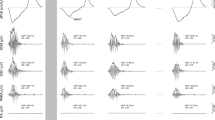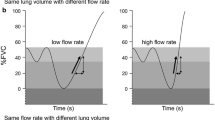Abstract
Purpose
To compare deoxygenation of the sternocleidomastoid, scalenes, and diaphragm/intercostals (Dia/IC) during submaximal intermittent neck flexion (INF) versus submaximal inspiratory threshold loading (ITL) in healthy adults.
Methods
Fourteen participants performed a randomized, cross-over, repeated measures design. After evaluation of maximal inspiratory pressures (MIP) and maximum voluntary contraction (MVC) for isometric neck flexion, participants were randomly assigned to submaximal ITL or INF until task failure. At least 2 days later, they performed the submaximal exercises in the opposite order. ITL or INF targeted 50 ± 5% of the MIP or MVC, respectively, until task failure. Near-infrared spectroscopy (NIRS) was applied to evaluate changes of deoxy-hemoglobin (ΔHHb), oxy-hemoglobin (ΔO2Hb), total hemoglobin (ΔtHb), and tissue saturation of oxygen (StO2) of the sternocleidomastoid, scalenes, and Dia/IC. Breathlessness and perceived exertion were evaluated using Borg scales.
Results
Initially during INF, sternocleidomastoid HHb slope was greatest compared to the scalenes and Dia/IC. At isotime (6.5–7 min), ΔtHb (a marker of blood volume) and ΔO2Hb of the sternocleidomastoid were higher during INF than ITL. Sternocleidomastoid HHb, O2Hb, and tHb during INF also increased at quartile and task failure timepoints. In contrast, scalene ΔO2Hb was higher during ITL than INF at isotime. Further, Dia/IC O2Hb and tHb increased during ITL at the third quartile and at task failure. Borg scores were lower at task failure during INF compared to ITL.
Conclusion
Intermittent INF induces significant metabolic activity of the sternocleidomastoid and a lower perception of effort, which may provide an alternative inspiratory muscle training approach for mechanically ventilated patients.



Similar content being viewed by others
Data availability
Data available on request due to privacy/ethical restrictions.
Abbreviations
- Dia/IC:
-
Diaphragm/intercostals
- INF:
-
Intermittent neck flexion
- ITL:
-
Inspiratory threshold loading
- HHb:
-
Deoxyhemoglobin
- ICU:
-
Intensive care unit
- MIP:
-
Maximal inspiratory pressure
- MV:
-
Mechanical ventilation
- MVC:
-
Maximal voluntary contraction
- NIRS:
-
Near-infrared spectroscopy
- O2Hb:
-
Oxyhemoglobin
- SCM:
-
Sternocleidomastoid
- StO2 :
-
Tissue saturation of oxygen:
- tHb:
-
Total hemoglobin
References
Adler D, Dupuis-Lozeron E, Richard J-C, Janssens J-P, Brochard L (2014) Does inspiratory muscle dysfunction predict readmission after intensive care unit discharge? Am J Repir Crit Care Med 190(3):347–350. https://doi.org/10.1164/rccm.201404-0655LE
Basoudan N, Shadgan B, Guenette JA, Road J, Reid WD (2016) Effect of acute hypoxia on inspiratory muscle oxygenation during incremental inspiratory loading in healthy adults. Eur J Appl Physiol 116(4):841–850. https://doi.org/10.1007/s00421-016-3334-x
Bertoni M, Telias I, Urner M, Long M, Del Sorbo L, Fan E, Goligher EC (2019) A novel non-invasive method to detect excessively high respiratory effort and dynamic transpulmonary driving pressure during mechanical ventilation. Crit Care 23(1):346. https://doi.org/10.1186/s13054-019-2617-0
Bissett B, Leditschke IA, Green M, Marzano V, Collins S, Van Haren F (2019) Inspiratory muscle training for intensive care patients: A multidisciplinary practical guide for clinicians. Aust Crit Care 32(3):249–255. https://doi.org/10.1016/j.aucc.2018.06.001
Borg GA (1982) Psychophysical bases of perceived exertion. Med Sci Sports Exerc 14(5):377–381. https://doi.org/10.1249/00005768-198205000-00012
Borisut S, Vongsirinavarat M, Vachalathiti R, Sakulsriprasert P (2013) Effects of strength and endurance training of superficial and deep neck muscles on muscle activities and pain levels of females with chronic neck pain. J Phys Ther Sci 25(9):1157–1162. https://doi.org/10.1589/jpts.25.1157
Brochard, L., Schreiber A. Muscle Recruitment during neck flexion and inspiratory muscle training (FLEX). ClinicalTrias.gov. ClinicalTrials.gov Identifier: NCT05710432. Posted Feb 2, 2023. Accessed August 20 2023 at https://classic.clinicaltrials.gov/ct2/show/NCT05710432.
Chiti L, Biondi G, Morelot-Panzini C, Raux M, Similowski T, Hug F (2008) Scalene muscle activity during progressive inspiratory loading under pressure support ventilation in normal humans. Respir Physiol Neurobiol 164(3):441–448. https://doi.org/10.1016/j.resp.2008.09.010
Damuth E, Mitchell JA, Bartock JL, Roberts BW, Trzeciak S (2015) Long-term survival of critically ill patients treated with prolonged mechanical ventilation: a systematic review and meta-analysis. Lancet Respir Med 3(7):544–553. https://doi.org/10.1016/S2213-2600(15)00150-2
De Troyer A, Boriek AM (2011) Mechanics of the respiratory muscles. Compr Physiol 1(3):1273–1300. https://doi.org/10.1002/cphy.c100009
De Troyer A, Loring S (1995) Actions of the respiratory muscles. Lung Biol Health Dis 85:535–535
Derbakova A, Khu S, Ho K, Lewis C, Ma T, Melo LT et al (2020) Neck and inspiratory muscle recruitment during inspiratory loading and neck flexion. Med Sci Sports Exerc. https://doi.org/10.1249/MSS.0000000000002271
Dres M, Demoule A (2018) Diaphragm dysfunction during weaning from mechanical ventilation: an underestimated phenomenon with clinical implications. Crit Care 22(1):73. https://doi.org/10.1186/s13054-018-1992-2
Dubb R, Nydahl P, Hermes C, Schwabbauer N, Toonstra A, Parker AM, Needham DM (2016) Barriers and strategies for early mobilization of patients in intensive care units. Ann Am Thorac Soc 13(5):724–730. https://doi.org/10.1513/AnnalsATS.201509-586CME
Evans JA, Whitelaw WA (2009) The assessment of maximal respiratory mouth pressures in adults. Respir Care 54(10):1348–1359
Falla D, Dall’Alba P, Rainoldi A, Merletti R, Jull G (2002) Location of innervation zones of sternocleidomastoid and scalene muscles–a basis for clinical and research electromyography applications. Clinical Neurophysiol 113(1):57–63. https://doi.org/10.1016/S1388-2457(01)00708-8
Gandevia S, McKenzie D, Plassman B (1990) Activation of human respiratory muscles during different voluntary manoeuvres. J Physiol 428(1):387–403. https://doi.org/10.1113/jphysiol.1990.sp018218
Goligher EC, Brochard LJ, Reid WD, Fan E, Saarela O, Slutsky AS, Ferguson ND (2019) Diaphragmatic myotrauma: a mediator of prolonged ventilation and poor patient outcomes in acute respiratory failure. Lancet Respir Med 7(1):90–98. https://doi.org/10.1016/S2213-2600(18)30366-7
Grassi B, Quaresima V (2016) Near-infrared spectroscopy and skeletal muscle oxidative function in vivo in health and disease: a review from an exercise physiology perspective. J Biomed Opt 21(9):091313. https://doi.org/10.1117/1.JBO.21.9.091313
Herridge MS, Chu LM, Matte A, Tomlinson G, Chan L, Thomas C, Levasseur M (2016) The RECOVER program: disability risk groups and 1-year outcome after 7 or more days of mechanical ventilation. Am J Respir Crit Care Med 194(7):831–844. https://doi.org/10.1164/rccm.201512-2343OC
Homma S, Fukunaga T, Kagaya A (1996) Influence of adipose tissue thickness on near infrared spectroscopic signal in the measurement of human muscle. J Biomed Opt 1(4):418–425. https://doi.org/10.1117/12.252417
Hudson AL, Gandevia SC, Butler JE (2007) The effect of lung volume on the co-ordinated recruitment of scalene and sternomastoid muscles in humans. J Physiol 584(Pt 1):261–270. https://doi.org/10.1113/jphysiol.2007.137240
Istfan R, Gómez CA, Applegate M, Rozenberg D, Reid WD, Roblyer D (2021) Hemodynamics of the sternocleidomastoid measured with frequency domain near-infrared spectroscopy towards non-invasive monitoring during mechanical ventilation. Biomed Opt Express 12(7):4147–4162. https://doi.org/10.1364/BOE.430423
Kubas C, Chen Y-W, Echeverri S, McCann SL, Denhoed MJ, Walker CJ (2017) Reliability and validity of cervical range of motion and muscle strength testing. J Strength Cond Res 31(4):1087–1096. https://doi.org/10.1519/JSC.0000000000001578
Laghi F, Shaikh HS, Morales D, Sinderby C, Jubran A, Tobin MJ (2014) Diaphragmatic neuromechanical coupling and mechanisms of hypercapnia during inspiratory loading. Respir Physiol Neurobiol 198:32–41. https://doi.org/10.1016/j.resp.2014.03.004
Marin T, Moore J (2011) Understanding near-infrared spectroscopy. Adv Neonatal Care 11(6):382–388. https://doi.org/10.1097/ANC.0b013e3182337ebb
McArdle WD, Katch FI, Katch VL (2010). Exercise physiology: nutrition, energy, and human performance: Lippincott Williams & Wilkins
Mehta AB, Syeda SN, Wiener RS, Walkey AJ (2015) Epidemiological trends in invasive mechanical ventilation in the United States: a population-based study. J Crit Care 30(6):1217–1221. https://doi.org/10.1016/j.jcrc.2015.07.007
Melo LT, Rodrigues A, Cabral EE, Tanaka T, Goligher EC, Brochard L, Reid WD (2022) Prefrontal cortex activation during incremental inspiratory loading in healthy participants. Respir Physiol Neurobiol 296:103827. https://doi.org/10.1016/j.resp.2021.103827
Nepomuceno V, Nepomuceno E, Regalo S, Cerqueira E, Souza R (2014) Electromyographic study on the sternocleidomastoid and pectoralis major muscles during respiratory activity in humans. J Morphol Sci 31(02):098–102. https://doi.org/10.4322/jms.060213
Nydahl P, Sricharoenchai T, Chandra S, Kundt FS, Huang M, Fischill M, Needham DM (2017) Safety of patient mobilization and rehabilitation in the intensive care unit. systematic review with meta-analysis. Ann Am Thorac Soc 14(5):766–777. https://doi.org/10.1513/AnnalsATS.201611-843SR
Orozco-Levi M, Lloreta J, Minguella J, Serrano S, Broquetas JM, Gea J (2001) Injury of the human diaphragm associated with exertion and chronic obstructive pulmonary disease. Am J Respir Crit Care Med 164(9):1734–1739. https://doi.org/10.1164/ajrccm.164.9.2011150
Parthasarathy S, Jubran A, Laghi F, Tobin MJ (2007) Sternomastoid, rib cage, and expiratory muscle activity during weaning failure. J Appl Physiol 103(1):140–147. https://doi.org/10.1152/japplphysiol.00904.2006
Poole DC, Sexton WL, Farkas GA, Powers SK, Reid MB (1997) Diaphragm structure and function in health and disease. Med Sci Sports Exerc 29(6):738–754. https://doi.org/10.1097/00005768-199706000-00003
Reid WD, MacGowan NA (1998) Respiratory muscle injury in animal models and humans. Mol Cell Biochem 179:63–80. https://doi.org/10.1023/A:1006803703128
Reid WD, Sheel AW, Shadgan B, Garland SJ, Road JD (2016) Recruitment and deoxygenation of selected respiratory and skeletal muscles during incremental loading in stable COPD patients. J Cardiopulm Rehabil Prev 36(4):279–287. https://doi.org/10.1097/HCR.0000000000000185
Rodrigues A, Louvaris Z, Dacha S, Janssens W, Pitta F, Vogiatizis I, Langer D (2019) Differences in respiratory muscle responses to hyperpnea or loaded breathing in COPD. Med Sci Sports Exerc. https://doi.org/10.1249/MSS.0000000000002222
Rodrigues A, Janssens L, Langer D, Matsumura U, Rozenberg D, Brochard L, Reid WD (2022) Semi-automated detection of the timing of respiratory muscle activity: validation and first application. Front Physiol 12:2322. https://doi.org/10.3389/fphys.2021.794598
Shadgan B, Guenette JA, Sheel AW, Reid WD (2011) Sternocleidomastoid muscle deoxygenation in response to incremental inspiratory threshold loading measured by near infrared spectroscopy. Respir Physiol Neurobiol 178(2):202–209. https://doi.org/10.1016/j.resp.2011.06.001
Shiraishi M, Higashimoto Y, Sugiya R, Mizusawa H, Takeda Y, Fujita S, Fukuda K (2023) Sternocleidomastoid muscle thickness correlates with exercise tolerance in patients with COPD. Respiration 102(1):64–73. https://doi.org/10.1159/000527100
Smith BK, Martin AD, Vandenborne K, Darragh BD, Davenport PW (2013) Correction: chronic intrinsic transient tracheal occlusion elicits diaphragmatic muscle fiber remodeling in conscious rodents. PLoS ONE. https://doi.org/10.1371/annotation/4d84ef28-da1b-4dba-9df6-e8f2ec51cced
Tanaka T, Basoudan N, Melo LT, Wickerson L, Brochard LJ, Goligher EC, Reid WD (2018) Deoxygenation of inspiratory muscles during cycling, hyperpnoea and loaded breathing in health and disease: a systematic review. Clin Physiol Funct Imaging 38(4):554–565. https://doi.org/10.1111/cpf.12473
Van Hollebeke M, Poddighe D, Clerckx B, Muller J, Hermans G, Gosselink R, Louvaris Z (2022) High-intensity inspiratory muscle training improves scalene and sternocleidomastoid muscle oxygenation parameters in patients with weaning difficulties: a randomized controlled trial. Front Physiol 13:786575. https://doi.org/10.3389/fphys.2022.786575
Villringer A, Planck J, Hock C, Schleinkofer L, Dirnagl U (1993) Near infrared spectroscopy (NIRS): a new tool to study hemodynamic changes during activation of brain function in human adults. Neurosci Lett 154(1–2):101–104. https://doi.org/10.1016/0304-3940(93)90181-J
Vorona S, Sabatini U, Al-Maqbali S, Bertoni M, Dres M, Bissett B, Goligher EC (2018) Inspiratory muscle rehabilitation in critically Ill adults. A systematic review and meta-analysis. Ann Am Thorac Soc 15(6):735–744. https://doi.org/10.1513/AnnalsATS.201712-961OC10.1513/AnnalsATS.201712-961OC
Wells CR, Fitzpatrick MC, Sah P, Shoukat A, Pandey A, El-Sayed AM, Galvani AP (2020) Projecting the demand for ventilators at the peak of the COVID-19 outbreak in the USA. Lancet Inf Dis 20(10):1123–1125. https://doi.org/10.1016/S1473-3099(20)30315-7
Wunsch H (2020) Mechanical ventilation in COVID-19: interpreting the current epidemiology. Am J Respir Crit Care Med (ja). https://doi.org/10.1164/rccm.202004-1385ED
Zakynthinos SG, Vassilakopoulos T, Roussos C (1995) The load of inspiratory muscles in patients needing mechanical ventilation. Am J Respir Crit Care Med 152(4):1248–1255. https://doi.org/10.1164/ajrccm.152.4.7551378
Funding
MM and DR were funded in part by Sandra Faire and Ivan Fecan Professorship in Rehabilitation Medicine. MM was also funded by a grant from the Ontario Respiratory Care Society and an Ontario Graduate Scholarship.
Author information
Authors and Affiliations
Contributions
WDR and ECG developed the concept and designed the study; all authors participated in study design; the analysis was performed by MM, DR, and WDR. All authors were involved in data interpretation; MM, DR, and WDR drafted the manuscript; all authors read, revised, and approved the final manuscript.
Corresponding author
Ethics declarations
Conflict of interest
None.
Additional information
Communicated by Guido Ferretti.
Publisher's Note
Springer Nature remains neutral with regard to jurisdictional claims in published maps and institutional affiliations.
Rights and permissions
Springer Nature or its licensor (e.g. a society or other partner) holds exclusive rights to this article under a publishing agreement with the author(s) or other rightsholder(s); author self-archiving of the accepted manuscript version of this article is solely governed by the terms of such publishing agreement and applicable law.
About this article
Cite this article
Miles, M., Davenport, P., Mathur, S. et al. Intermittent neck flexion induces greater sternocleidomastoid deoxygenation than inspiratory threshold loading. Eur J Appl Physiol 124, 1151–1161 (2024). https://doi.org/10.1007/s00421-023-05338-6
Received:
Accepted:
Published:
Issue Date:
DOI: https://doi.org/10.1007/s00421-023-05338-6




